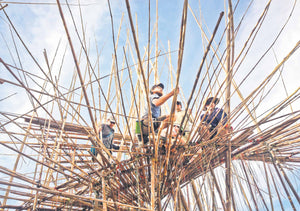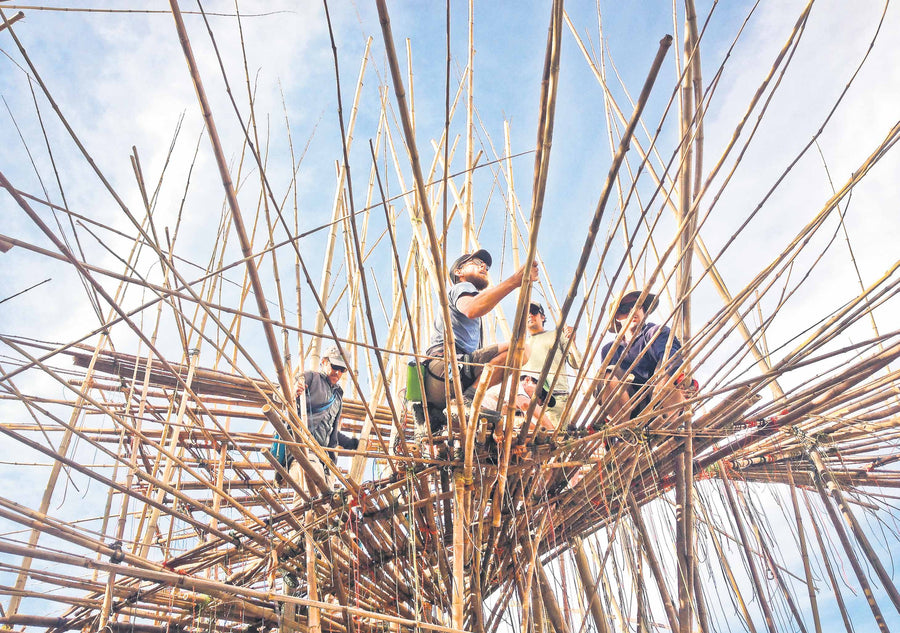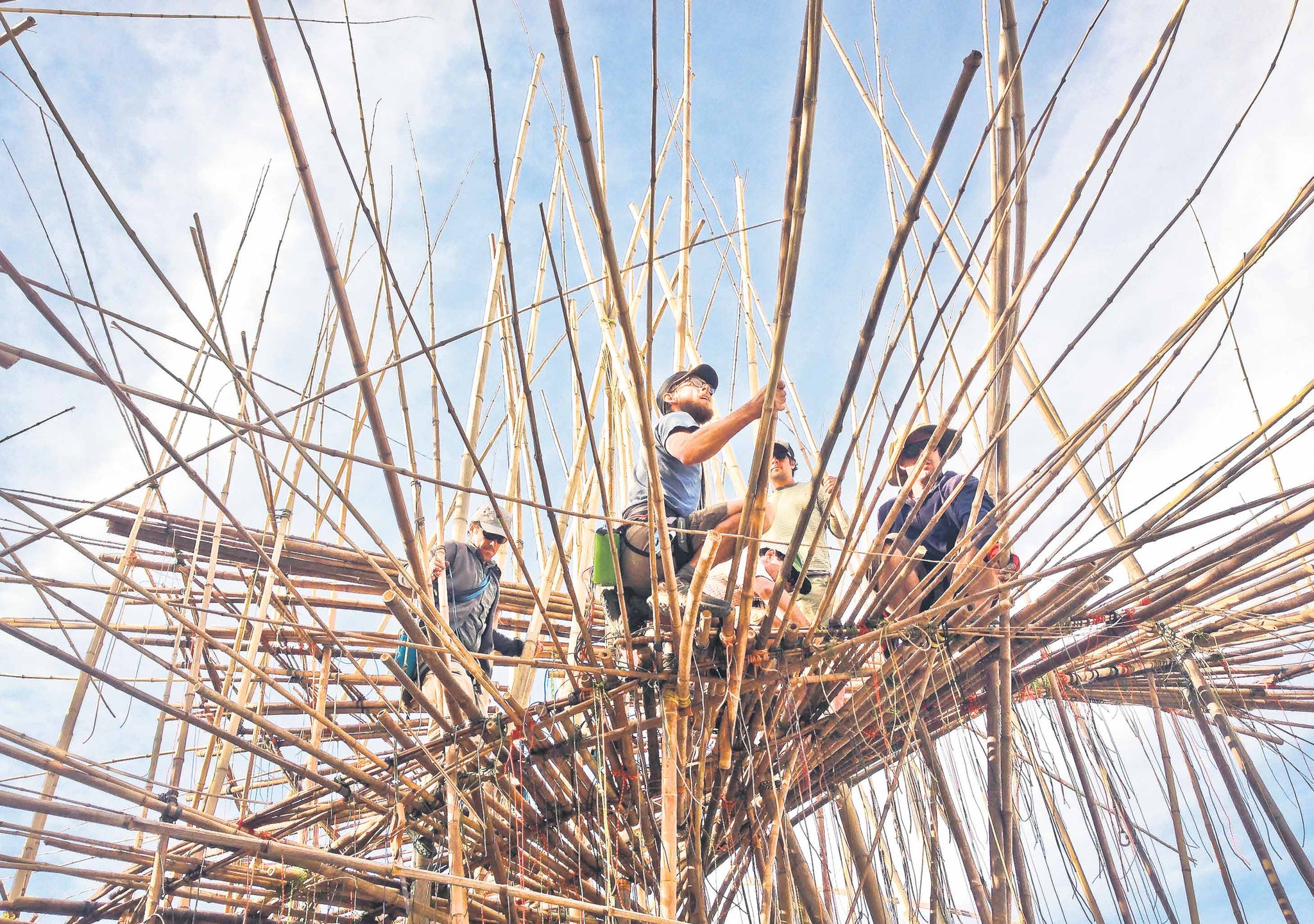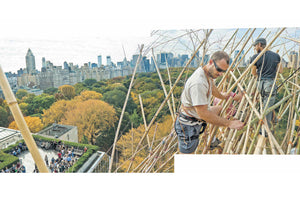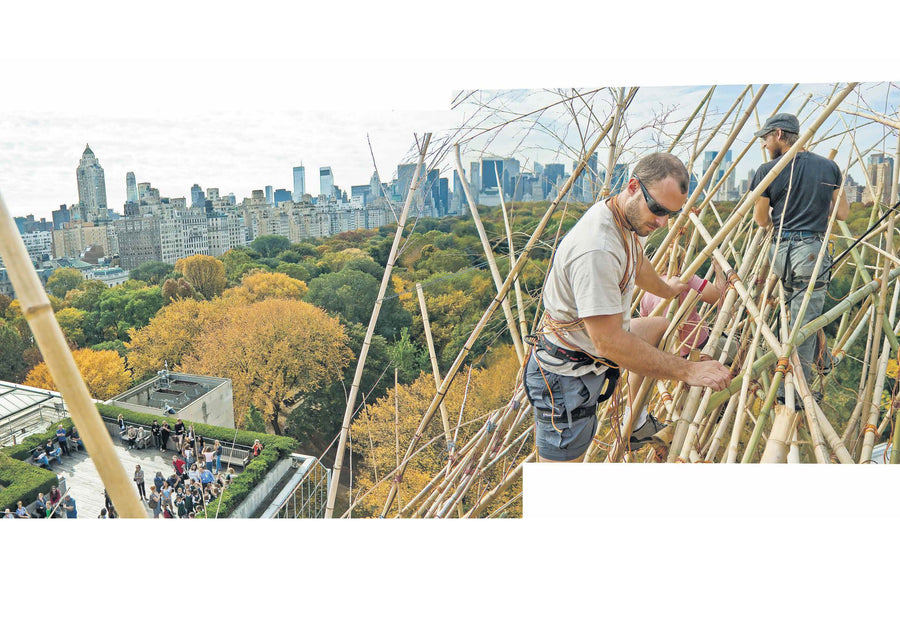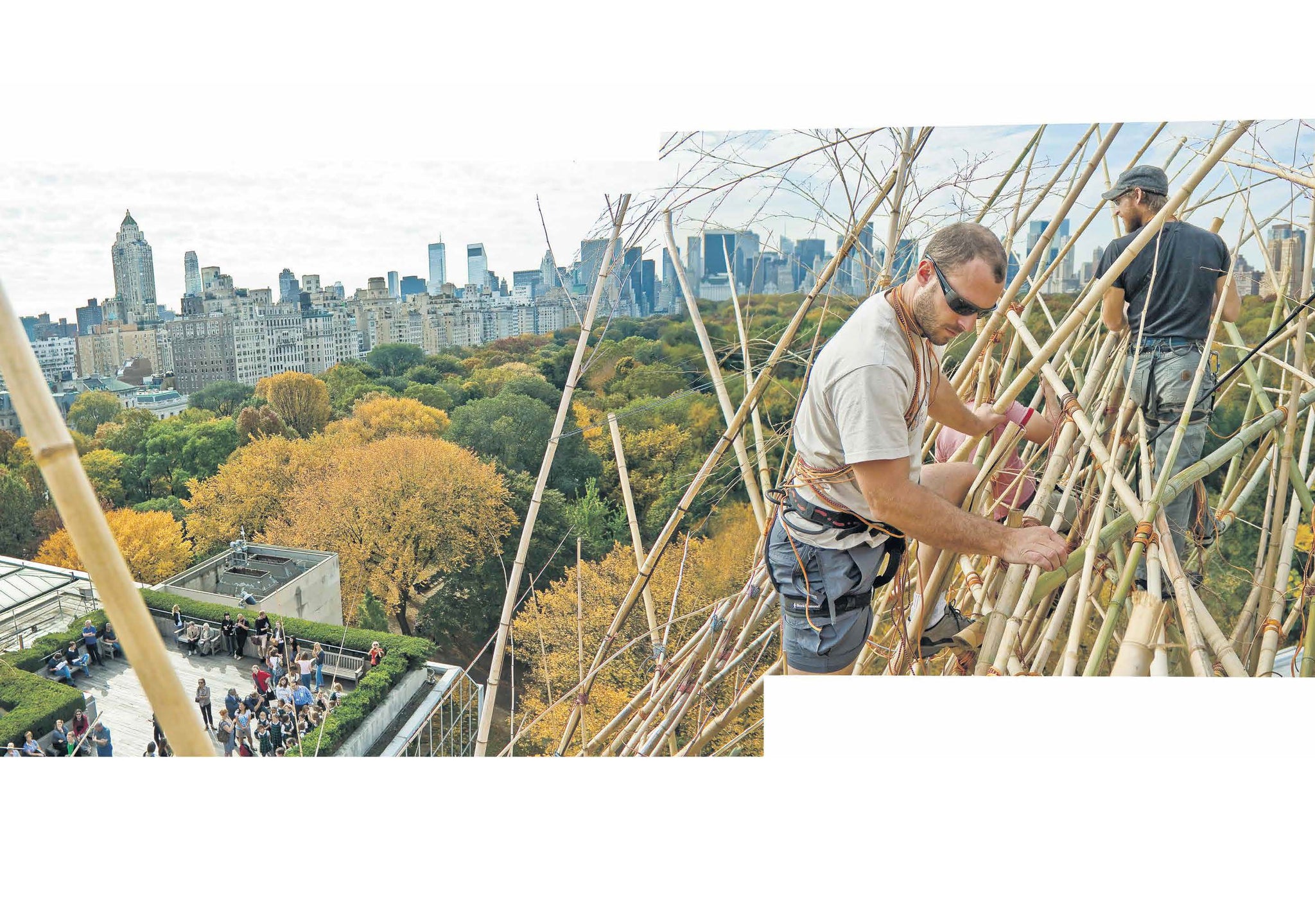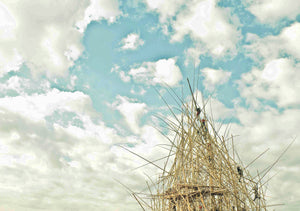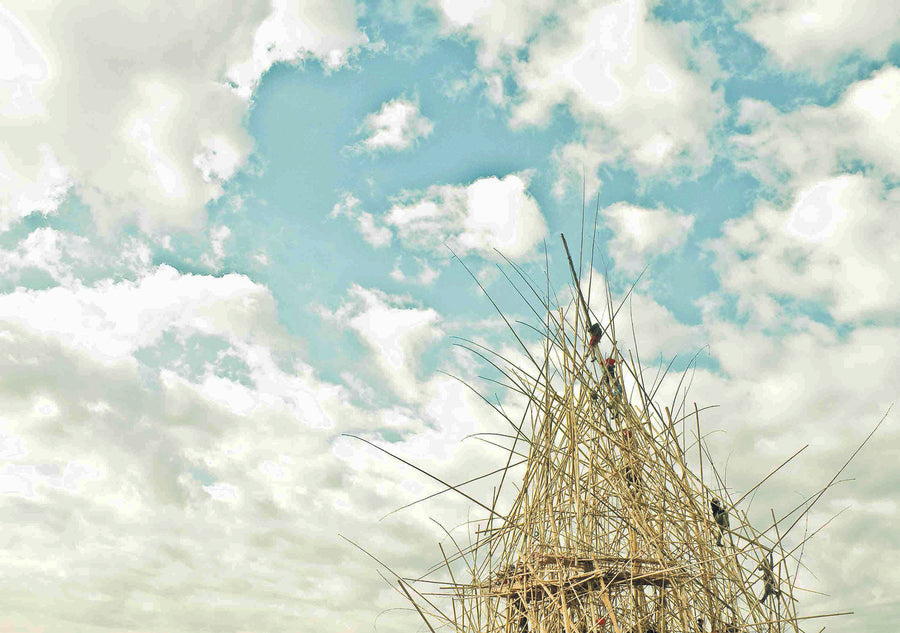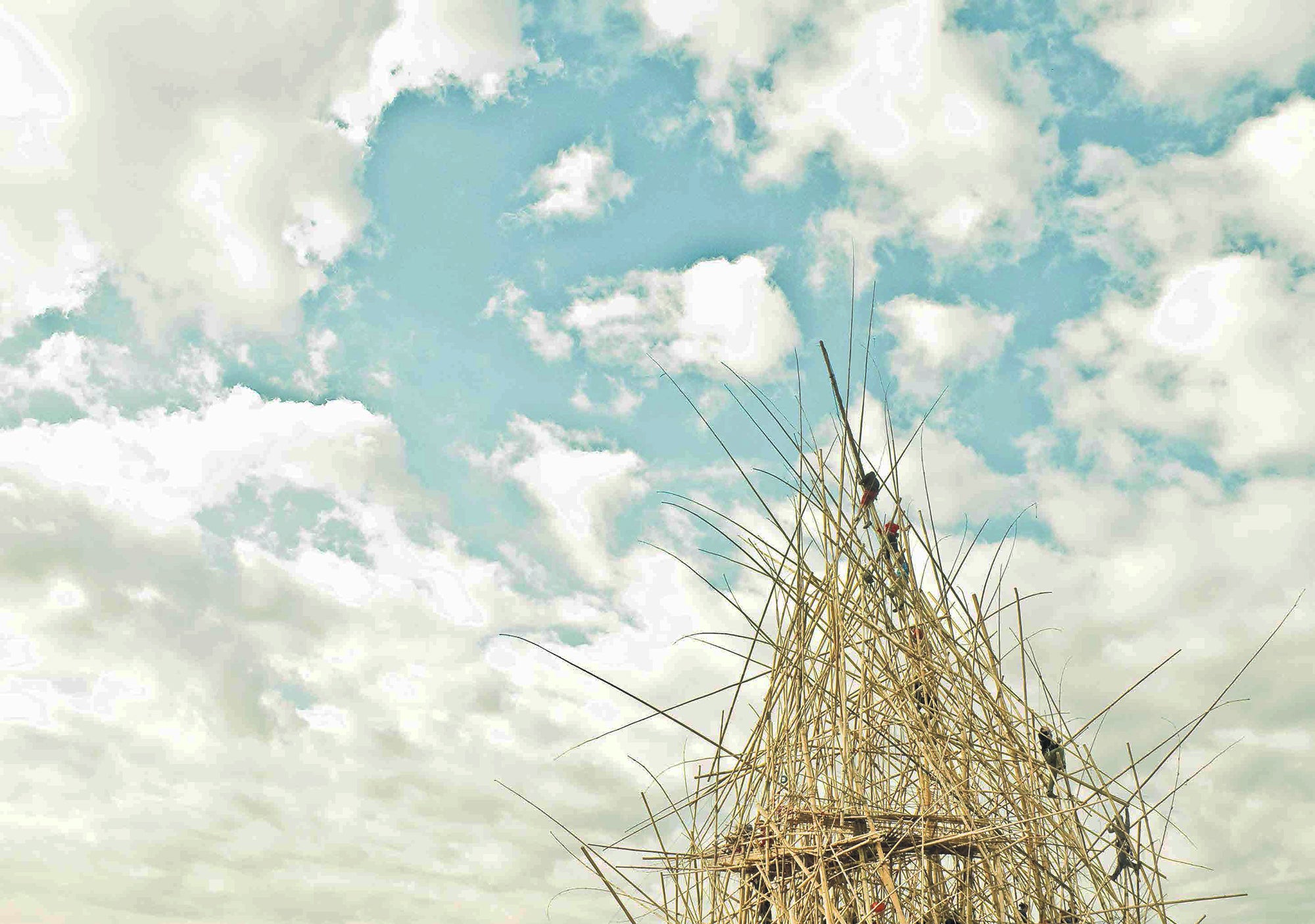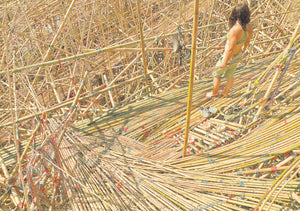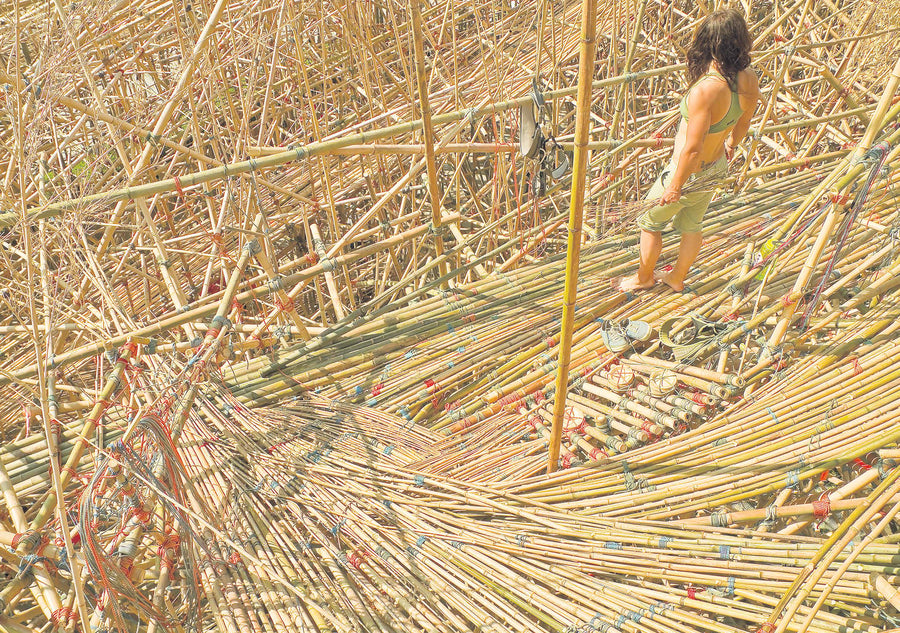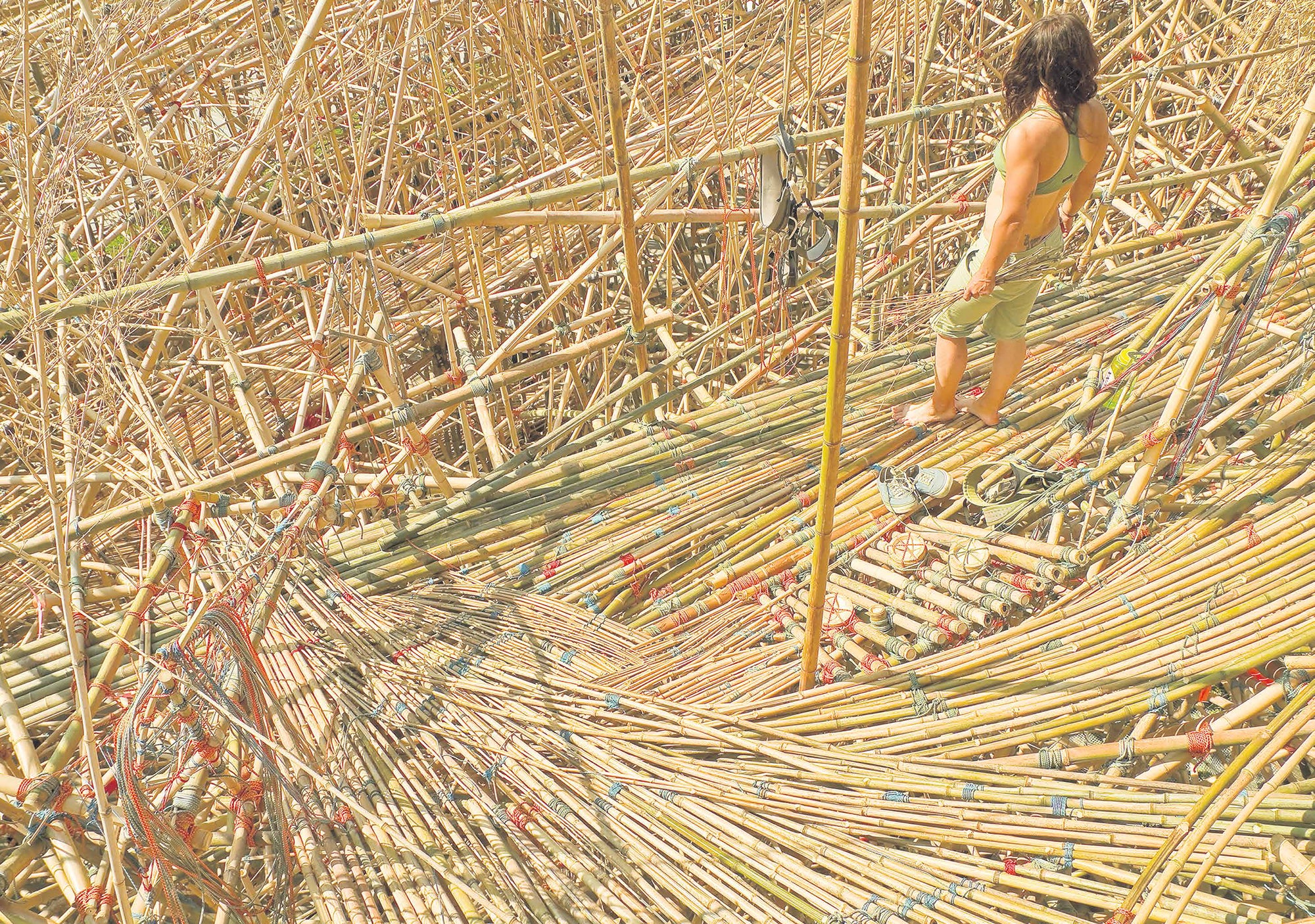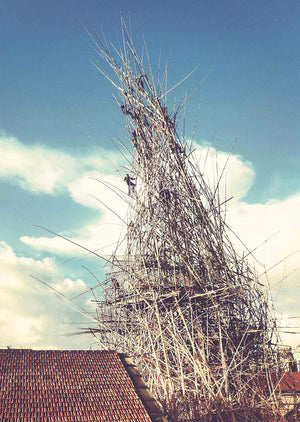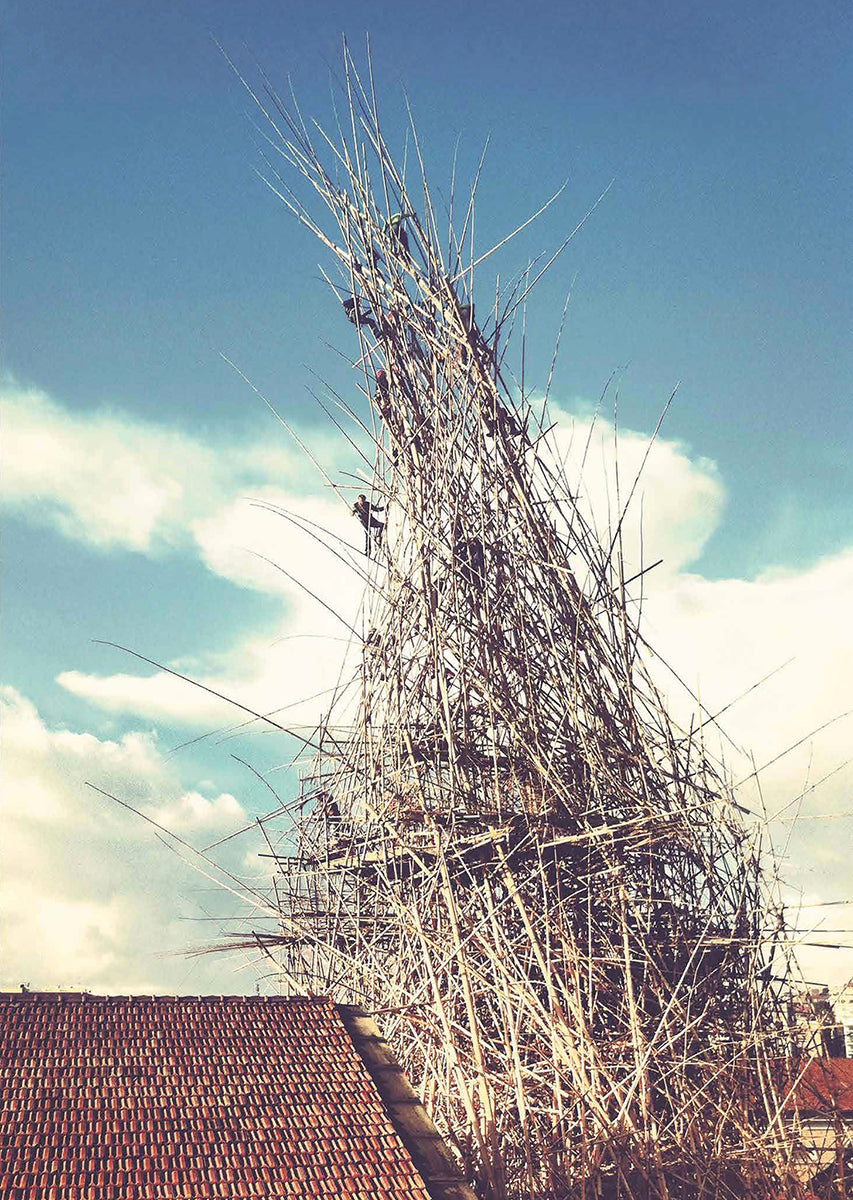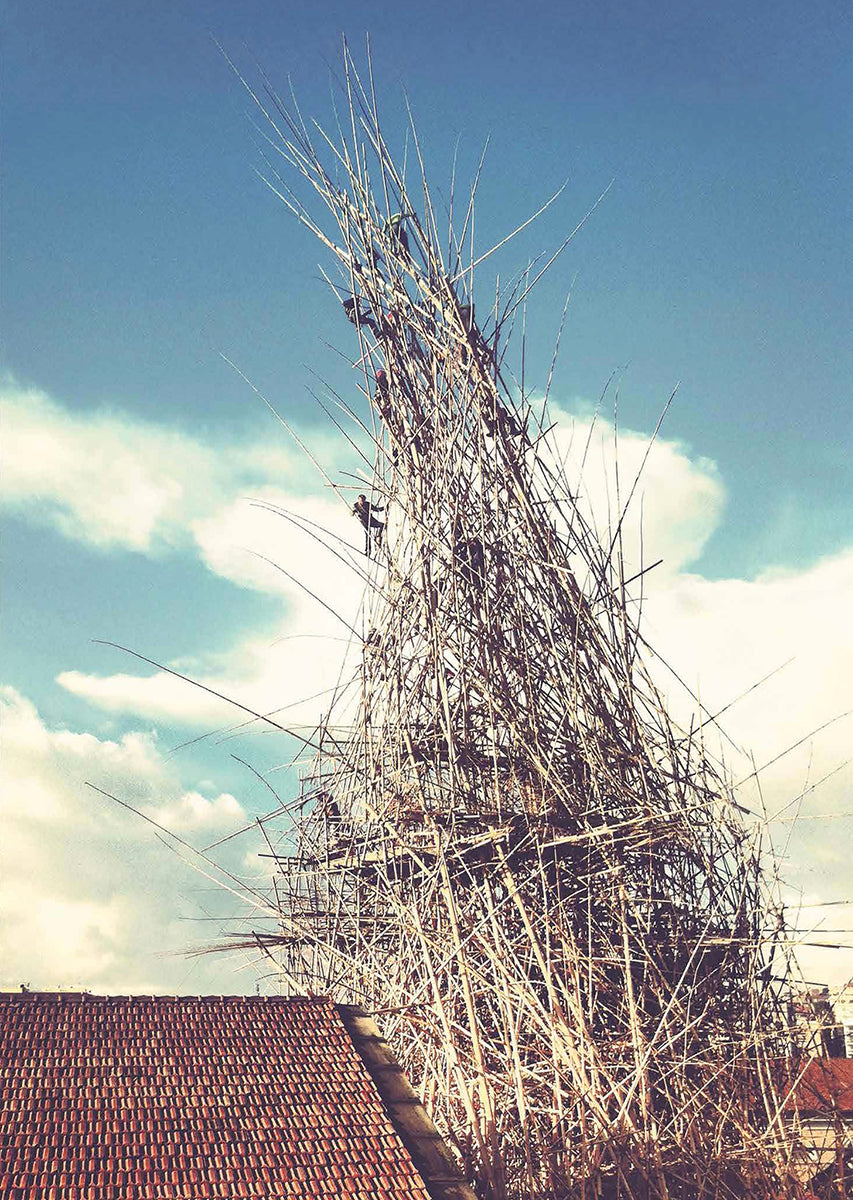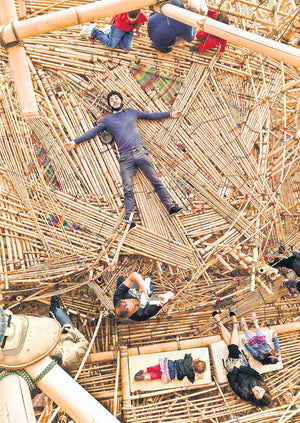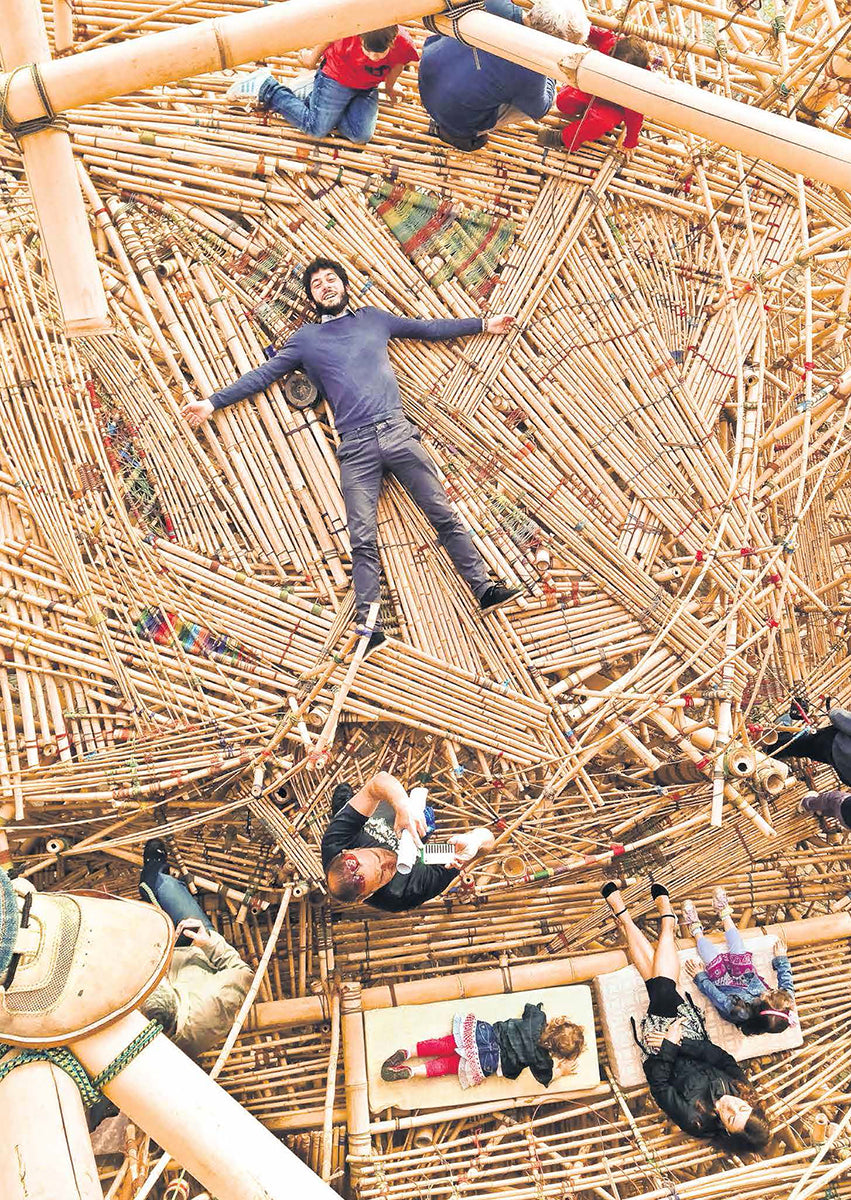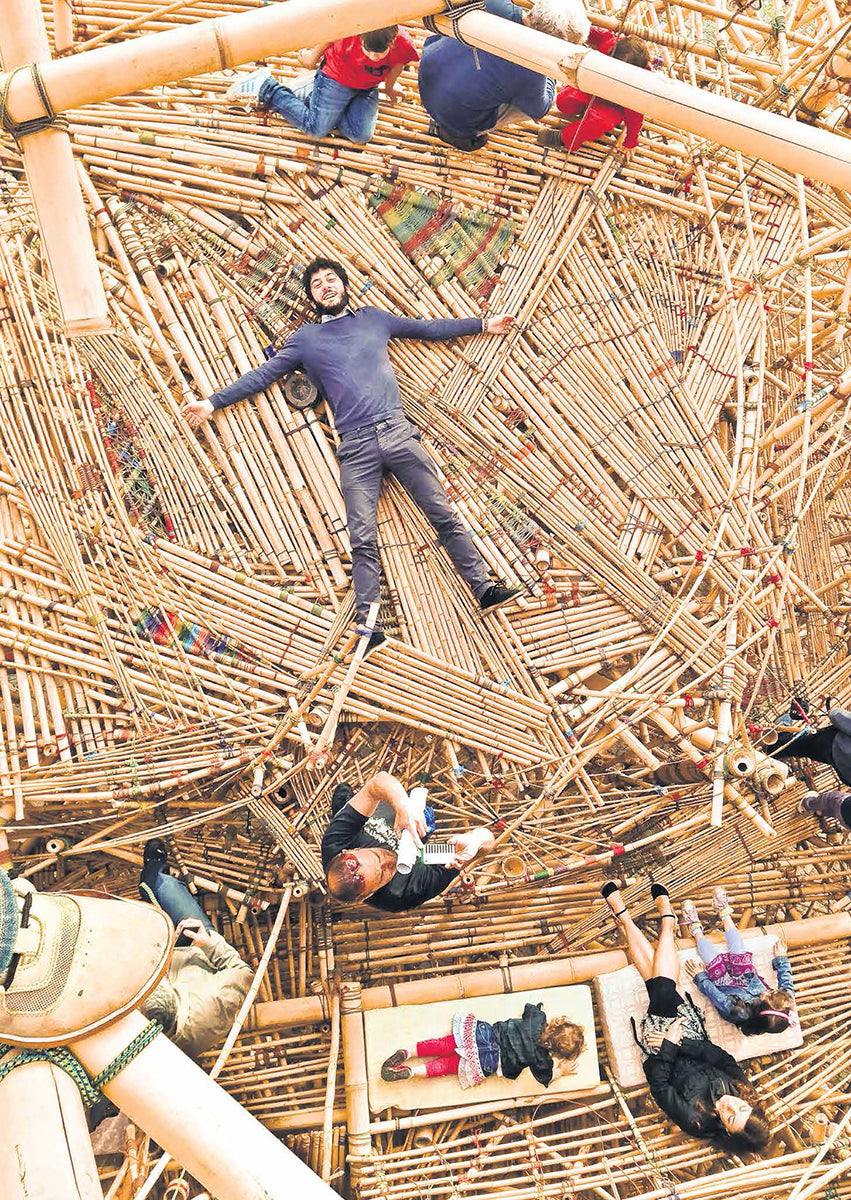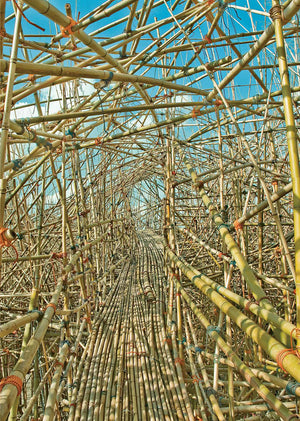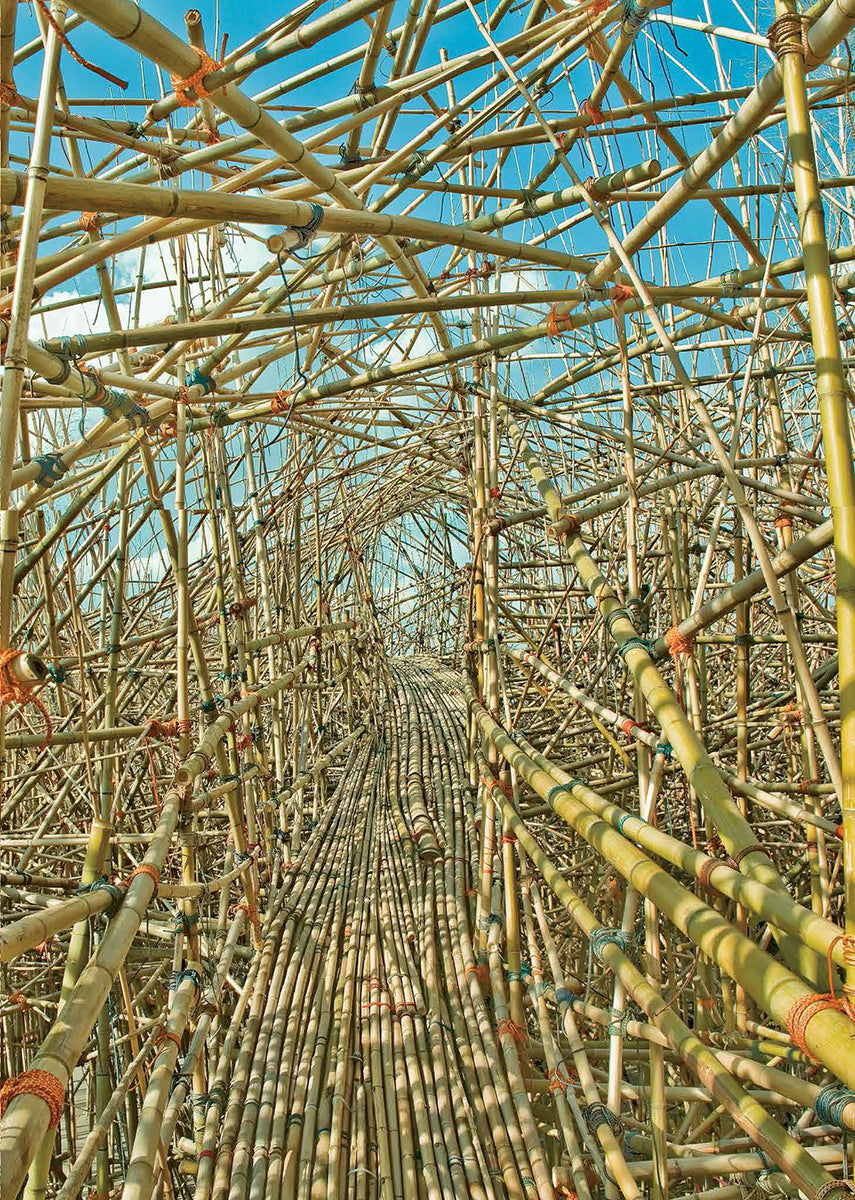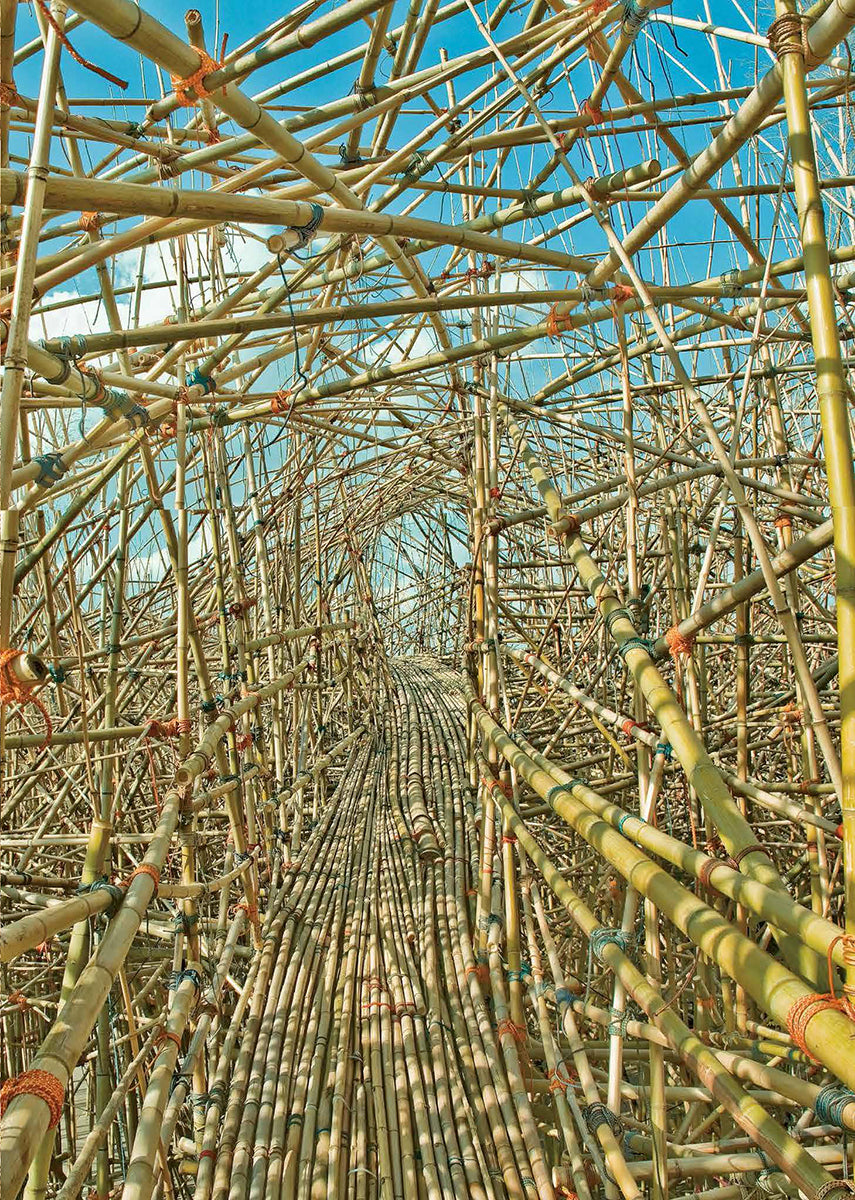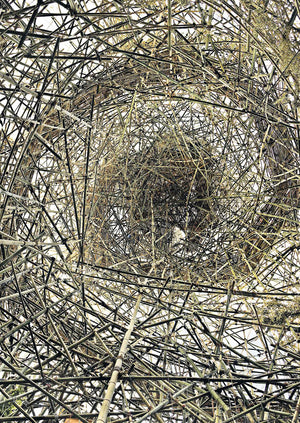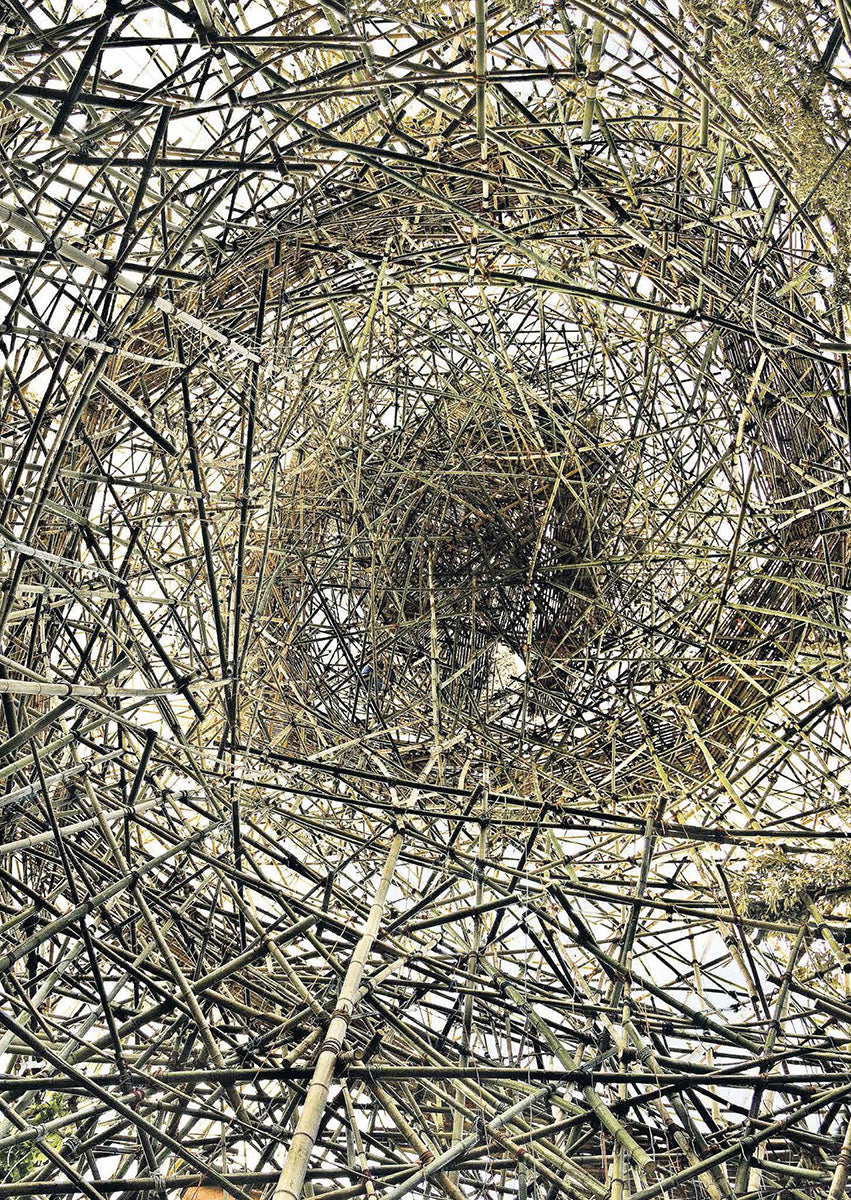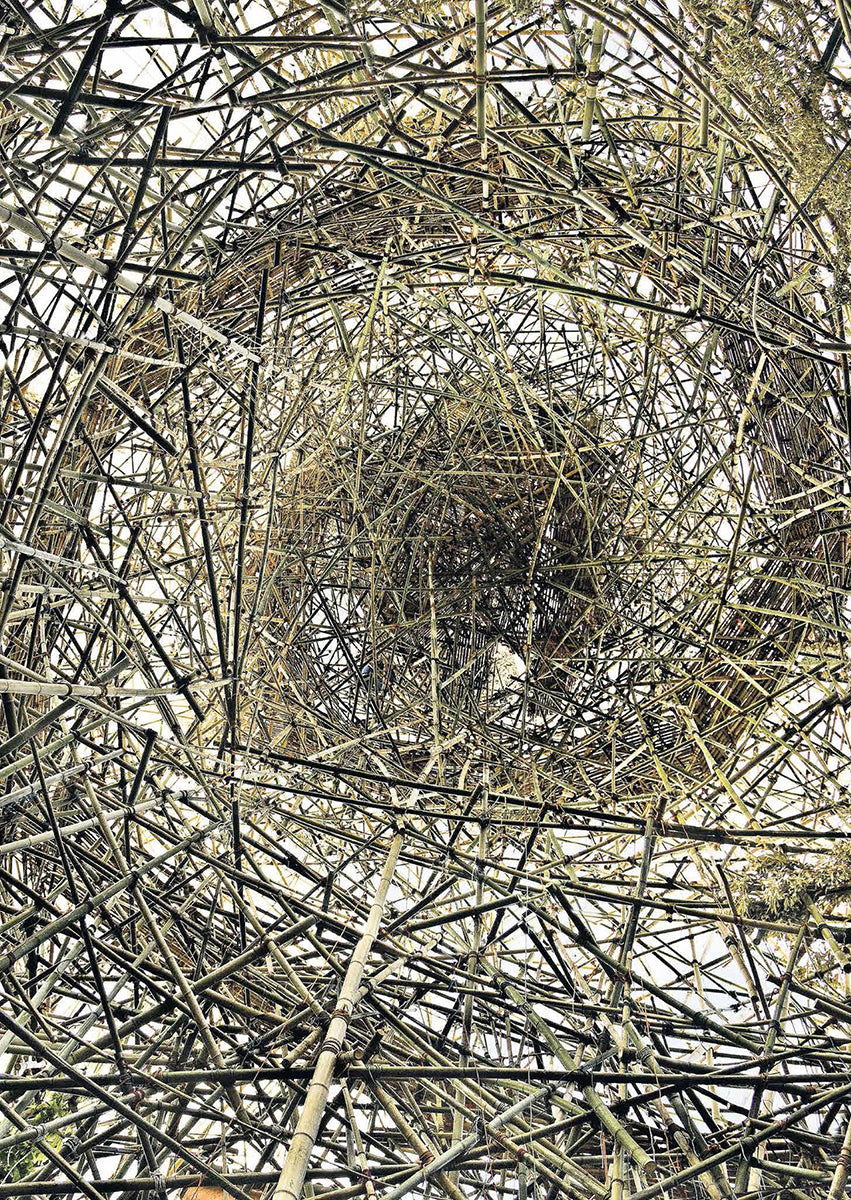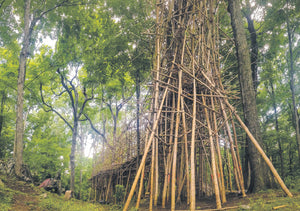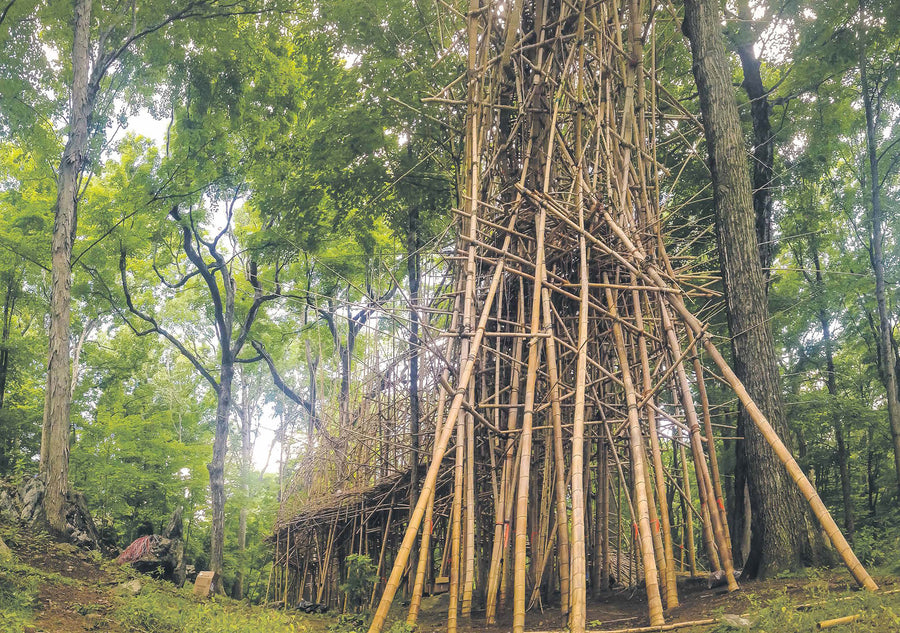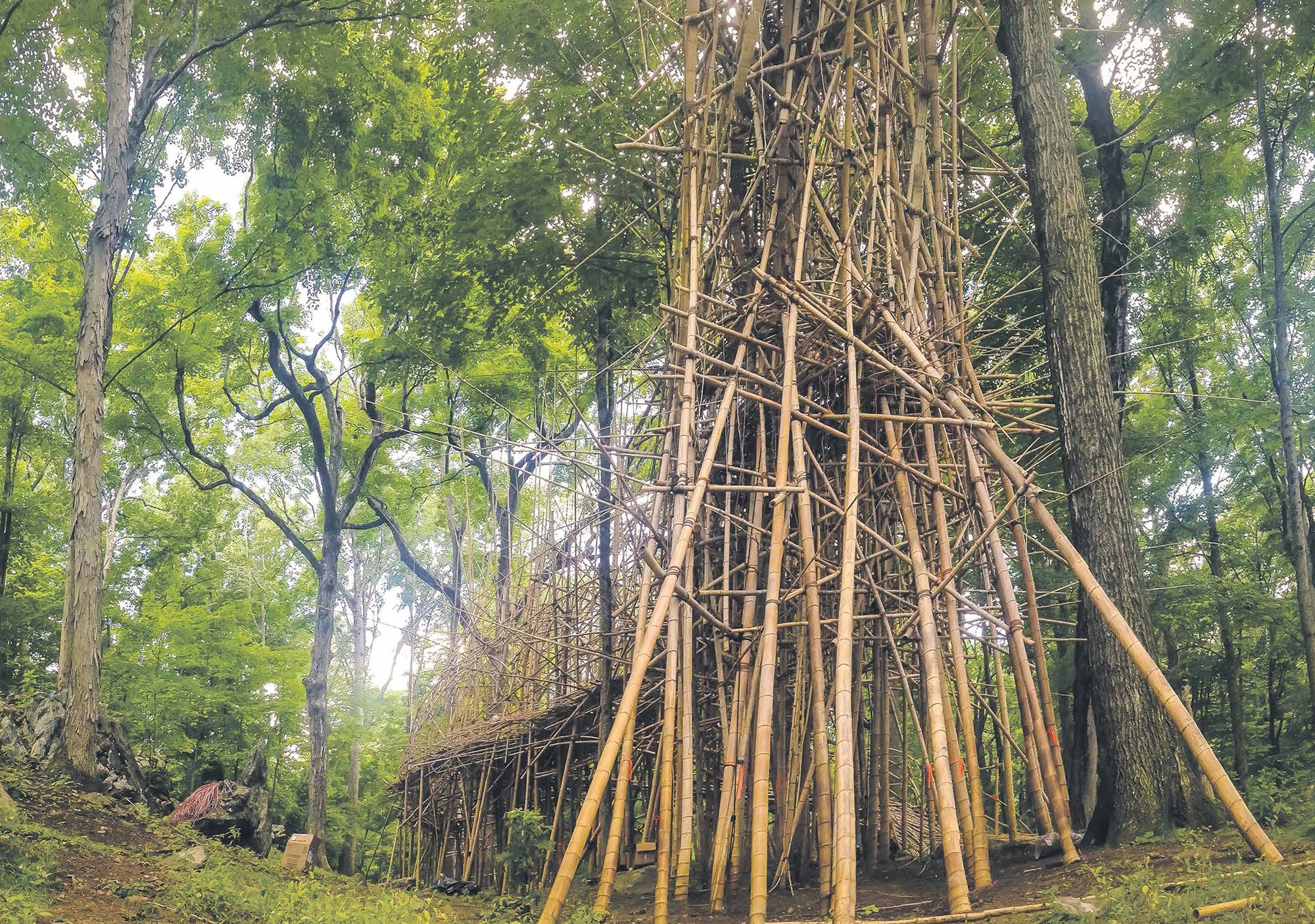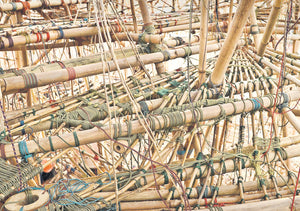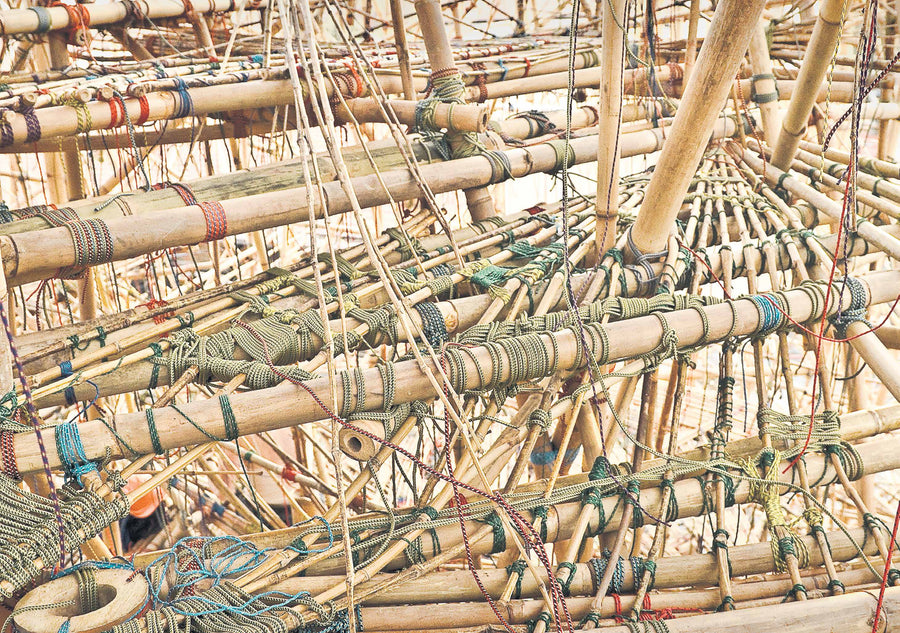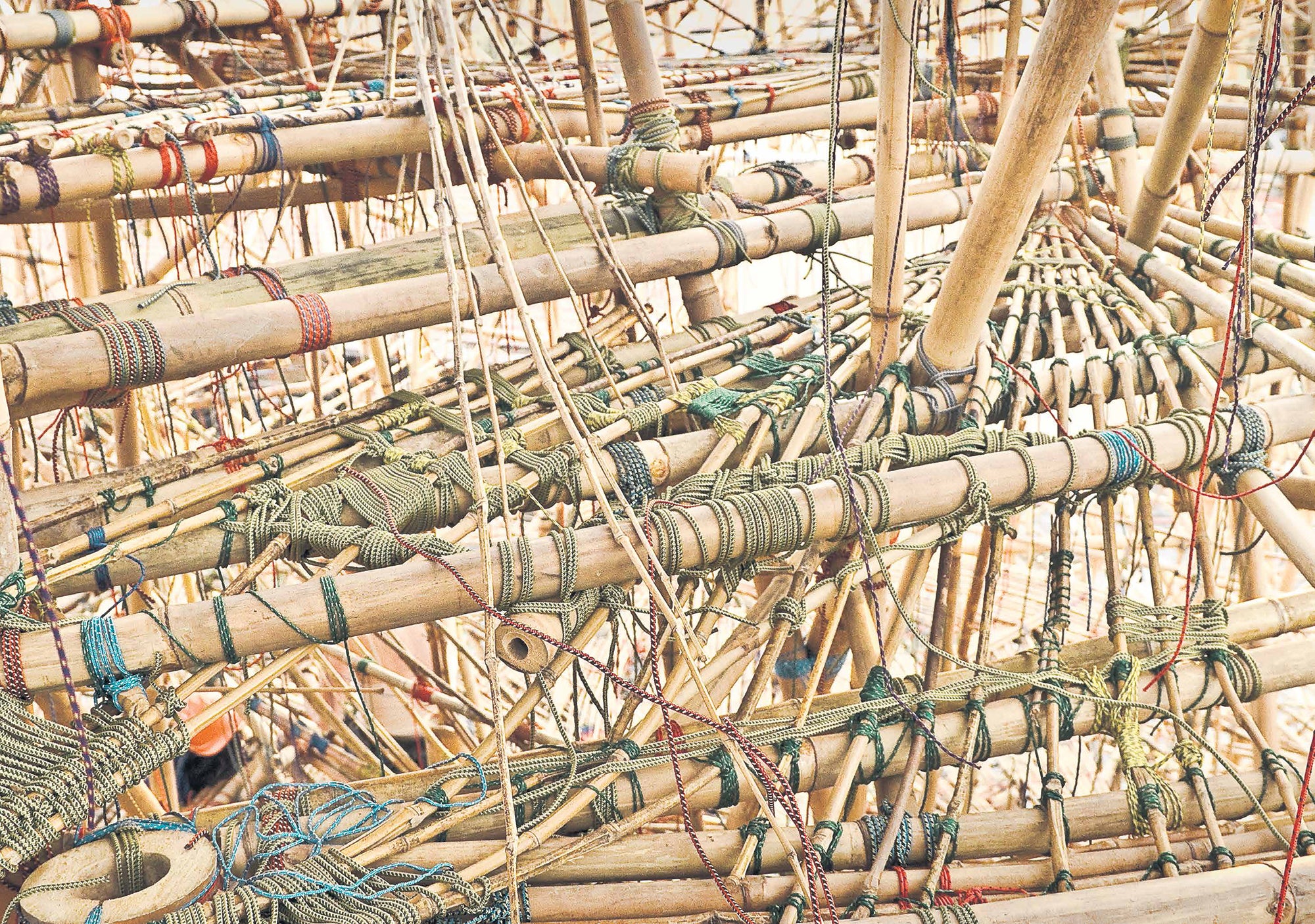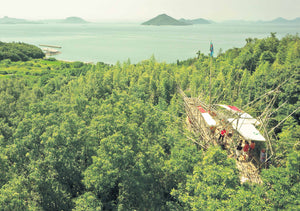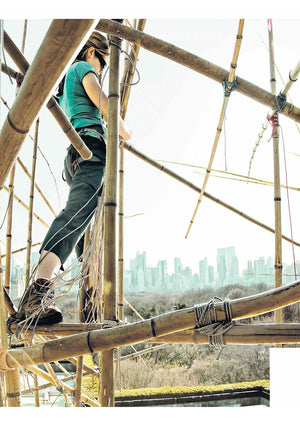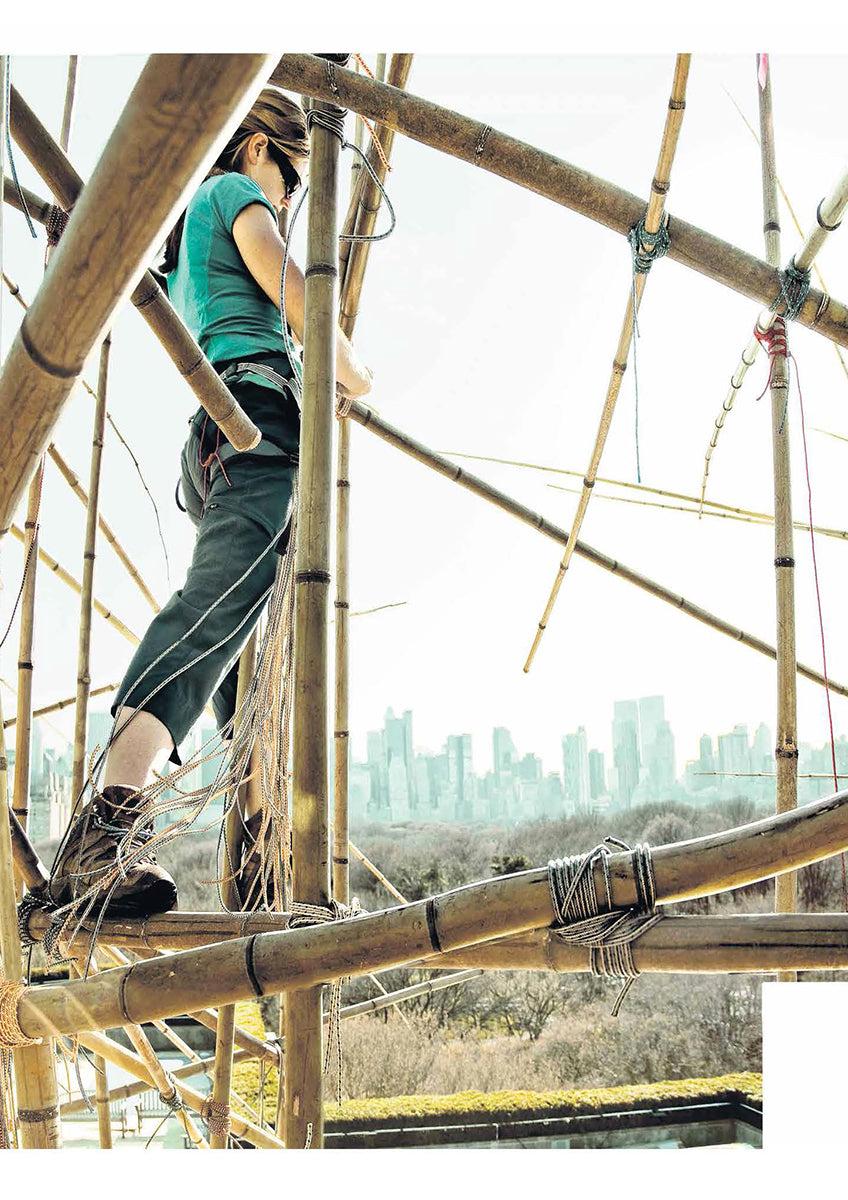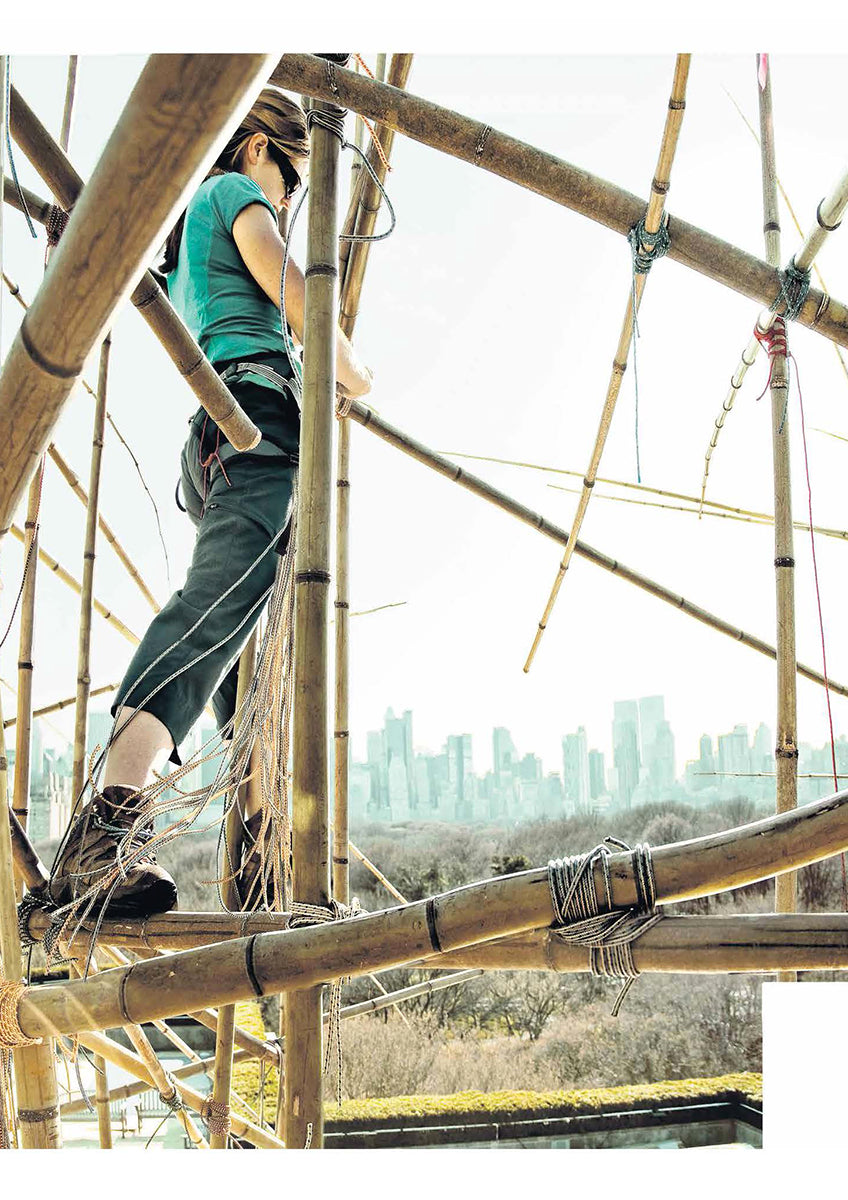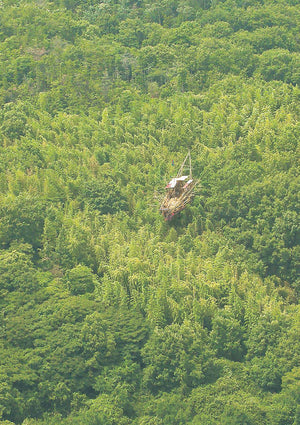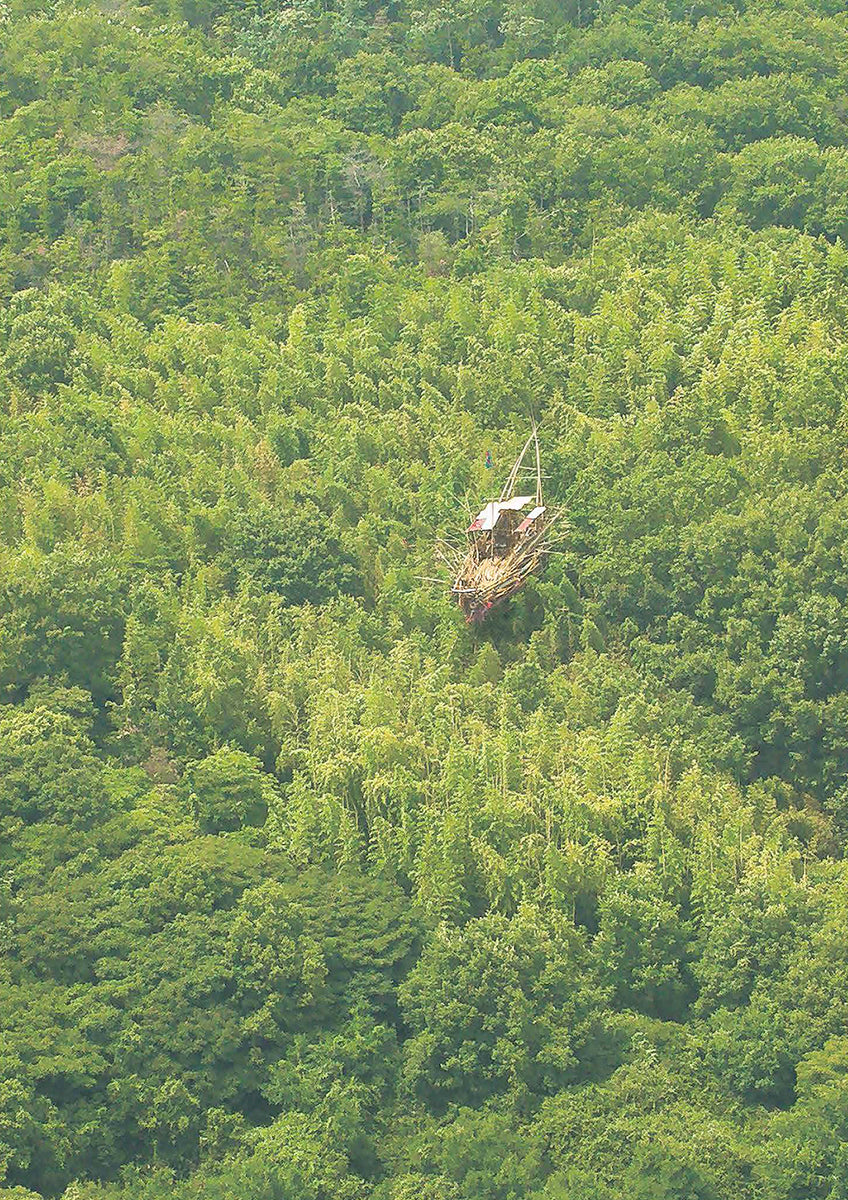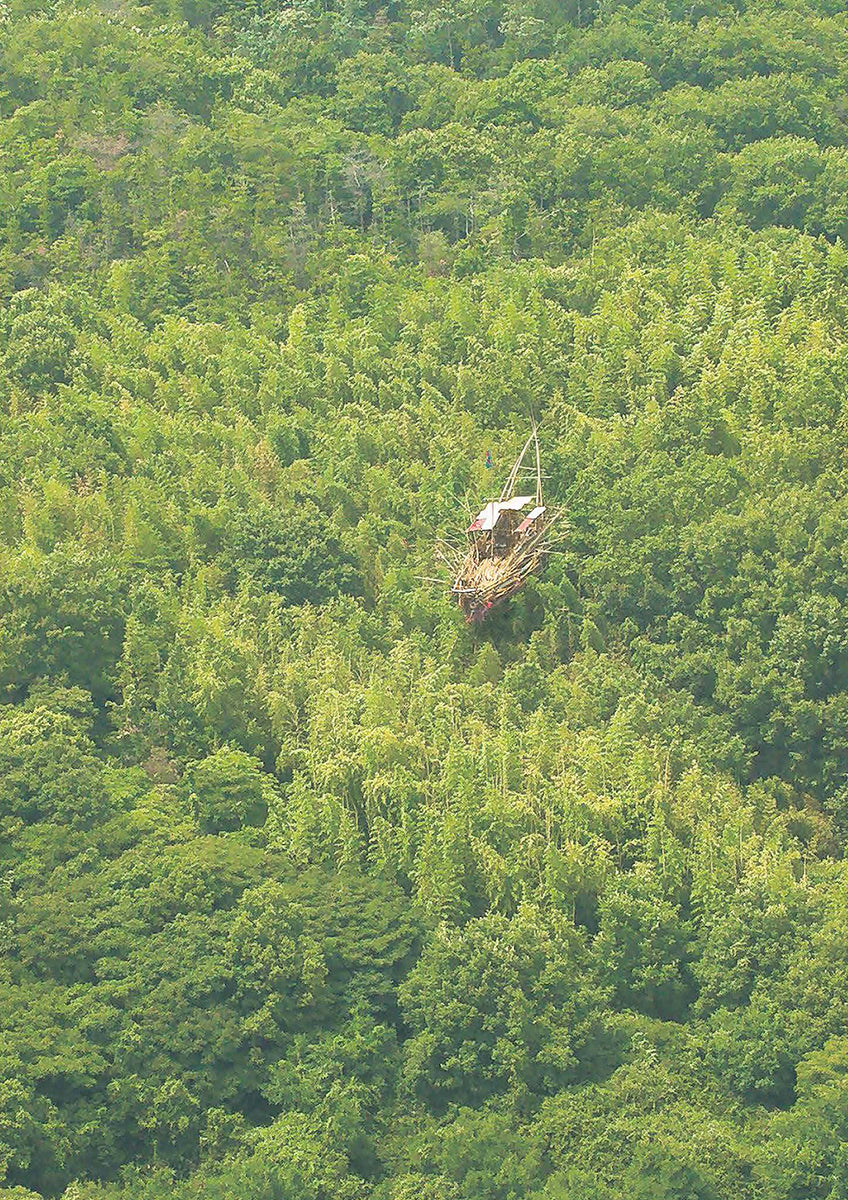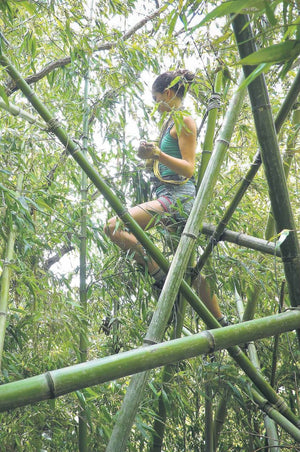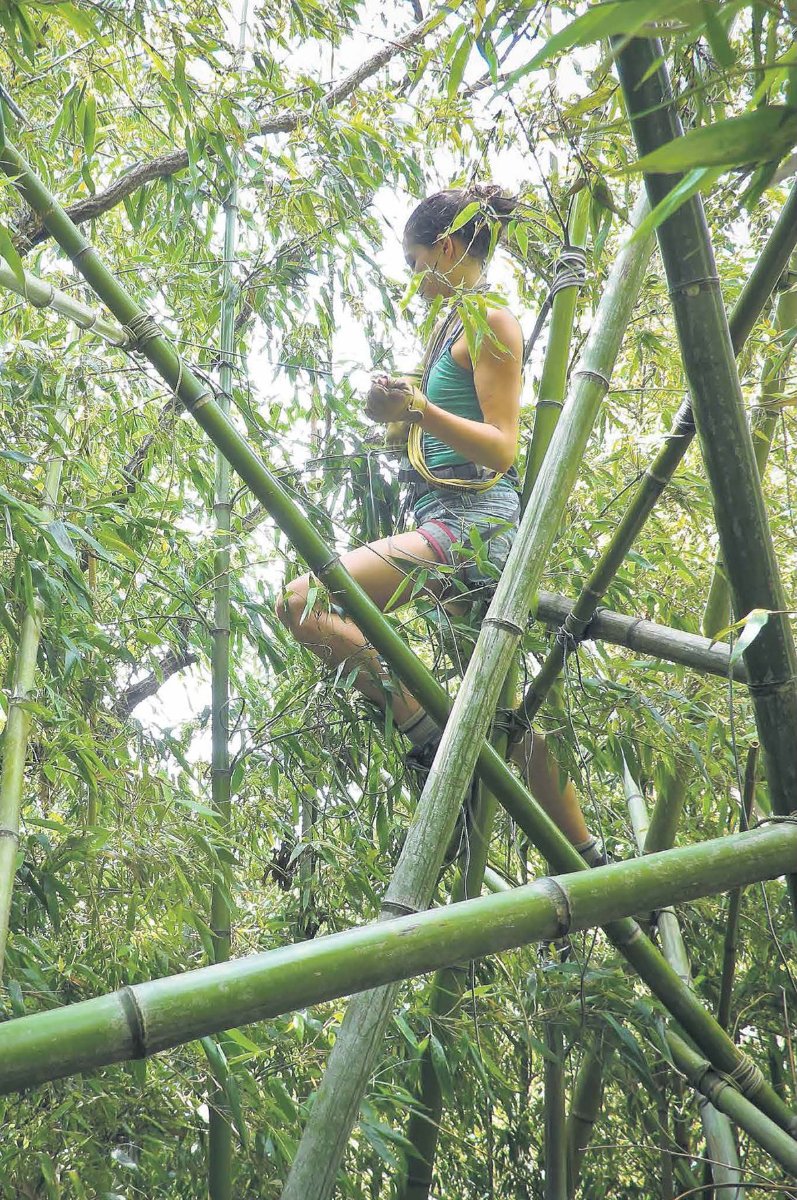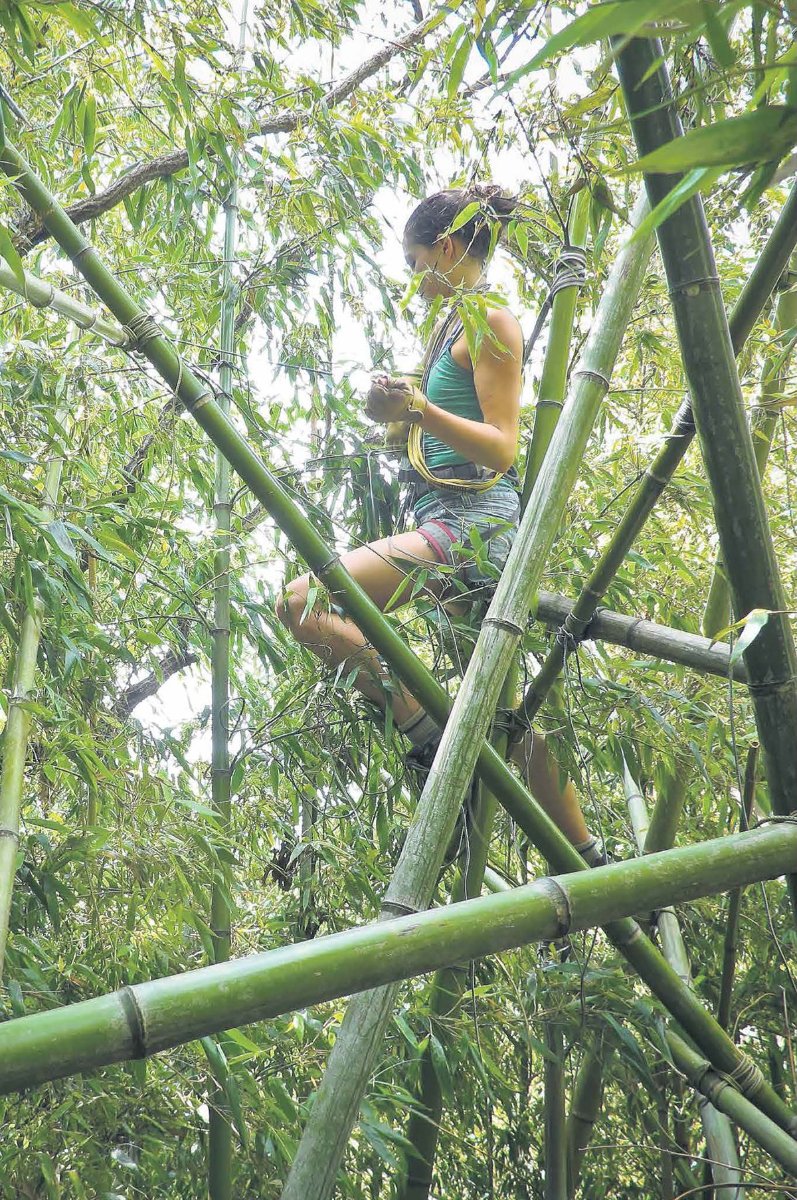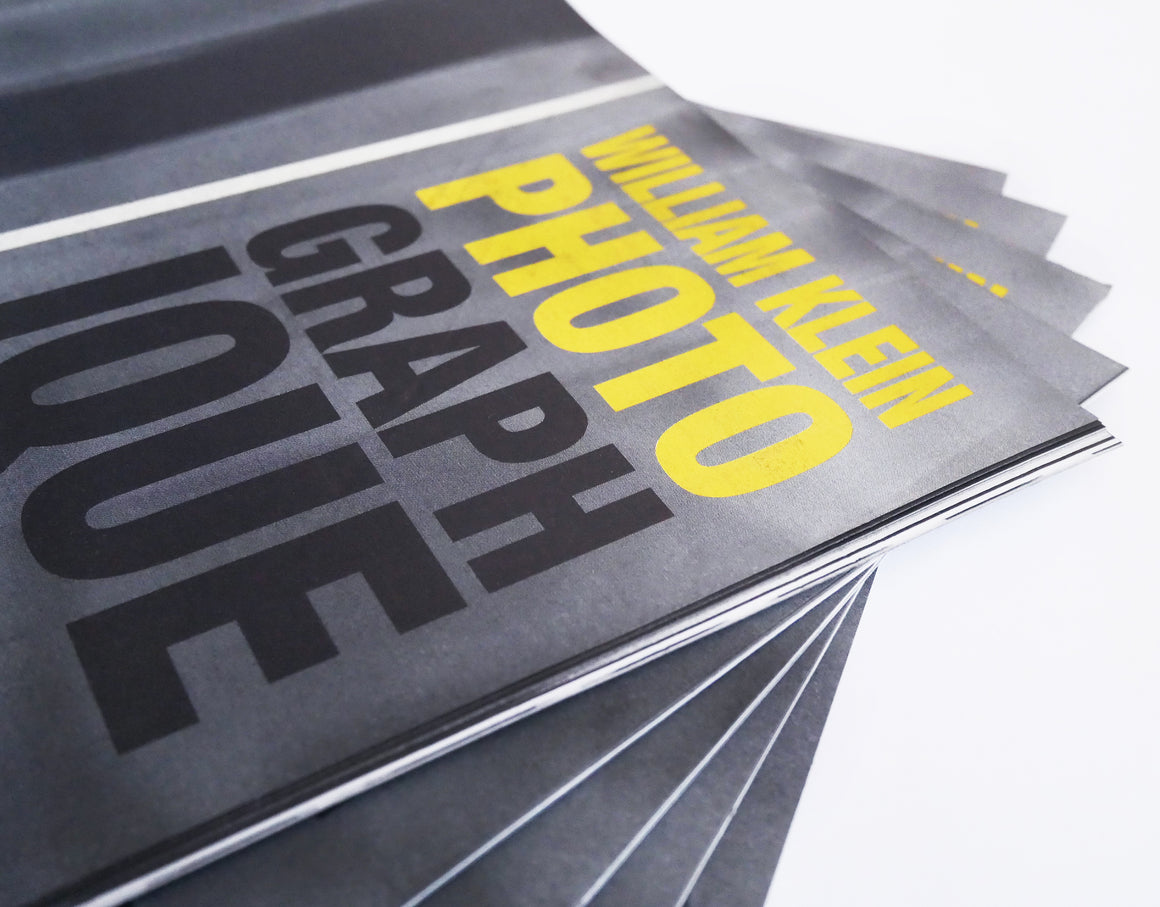
- – Mike + Doug Starn: Big Bambú
- + Philosophy & Ethos
- + Career narrative
- + Exhibition and collection history
- + Awards & Public Commissions
-
“An invisible architecture exists in the world, it is what we build our lives around and teach our children to work in. It’s the random interdependence of moments, actions becoming interactions, trajectories intersecting, creating growth and change. Big Bambú is the medium of life—the voices of individuals working in conversation with each other, a collaborative creative act reaching upwards.”
Read more through the page details below: -
Since they first received critical acclaim in the 1987 Whitney Biennale, Doug & Mike Starn have conducted philosophical and metaphorical dialogues with life, bridging art to physics, biology and cognitive science. Their work is based upon research and intuitive reflections and interpretations of the transfer of knowledge through an elaborate personal lexicon of metaphors. You can read more about the ideas that inform and animate the various Big Bambú iterations from 2008-2018 by clicking through the illustration details below. Here we take a wider view of the series and installations that pre-date Big Bambú, from Behind Your Eye at The Neuberger Museum of Art Purchase, NY in 2004, Absorption + Transmission at The National Academy of Sciences, Washington DC, 2005 to Gravity of Light, at Färgfabriken Kunsthalle, Stockholm in 2005, The Wood Street Galleries / at the Pipe Building, Pittsburgh in 2008, and at the Holy Cross-Immaculata Church for the Cincinnati Art Museum in 2012.
“…Vision doesn’t work like a camera, the mind is an interpreter of constantly fed information. Not just from your eyes, but also from all of your sensory inputs simultaneously, these are your interfaces to the world. Your mind decodes and understands the information based on a lifetime of constructions, memories, desires and learning…it is through all that that we ‘see’…”
The Starns often incorporate images of neuronal synaptic arbors overlapped and intertwined with dentritic tree branches, underscoring the connection of the internal and external worlds.
“The classical metaphor of light is knowledge and information. Trees are literally a recording of light, growing, through photosynthesis, towards the source. Trees are mostly carbon (and the allotrope of carbon most familiar is black). Black is, in the color spectrum, literally the absorption of all visible light. We use this symbolically in our silhouetted images of trees; in this understanding, we relate the black of body of the trees to the black of written information, the black ink on the pages of books through thousands of years of transcribed thought and creation. The Sun writes of its complex knowledge and describes itself, the trees as containers of comprehensive information and layered knowledge. The interconnectedness of trees-branches over branches into branches. Web, network, synapses, like dendritic neurons in the brain. The network of information and links. The pictogram nature of Chinese calligraphy is in relation to the silhouetted form of trees; the layered dendritic branches are in relation to the complexities of knowledge, understanding, memory and imagination. These trees are light written in the calligraphy of the sun.”
Light is the basis of photography and of vision, it is for the Starns the most powerful force. The gravitational power and force of the sun, the source of light, and the physics of color juxtaposed with the control light has over their chosen subjects, has many coincidences and convergences of physical fact and metaphor. The Starns photograph these subjects and conceive printing techniques to elucidate their metaphors, mixing non-traditional silver printing techniques and hi-technology with digital manipulation. From their satellite-photographed images in the early '90s, to the macroscopic and microscopic observations of the nature of moths, leaves and neurons, they offer a journey into relativity. Mike and Doug Starn, through their personal semiology, portray new models of the mind and its conception of itself in experiencing the world.
“Light is more than enlightenment; it is the gravity of all our past experiences and our future, the conscious and unconscious, the external and internal factors that drive our lives. The pull of gravity that light has over the corporeal body of the moths is like breathing, like thinking, impossible to deny; involuntarily, moth’s wings bring them to the light.” (Demetrio Paparoni, "Tree of Life," from Attracted to Light; powerHouse, 2003).
Descartes claimed that the blind see with their hands; it is a positivist view that to touch something, to determine its contours, is to know it: I “see” it, therefore it is. But this idea does not so much redress but renew the gulf between seeing and knowing: the classic mind-body problem. Centuries later, the French phenomenologist philosopher Maurice Merleau-Ponty refocused Descartes’ analysis. “There is no vision without thought,” he wrote. “But it is not enough to think in order to see.” In other words, our bodies—our vision—are the permanent condition of our experience, and thought is born by what happens in and on the body. We are conductors; absorbers and emitters of the universe’s energy.
A leaf falls from a tree. A flash of light crosses a shadowed statue. A snowflake dissolves in the air. And in a darkened exhibition hall, an icy blue radiance sizzles and flashes.
Gravity of Light, as much a system of transmissions as an exhibition of objects for contemplation. Part sculpture, part scientific experiment, the peculiar thirteen-foot-tall mechanical structure at its center was titled Leonardo’s St. John or This is my Middle Finger (2005). In the painting by da Vinci (himself an artist-inventor and maker of meaning), John the Baptist points his finger to the heavens, indicating the path to enlightenment. In the Starns’ carbon arc lamp—an adaptation of an 1804 model by British physicist Humphry Davy—electrifies that light with carbon-rod “fingers” that conduct a current between their respective nodes, producing a brilliant point of light too dazzling for the naked eye. Taped like a notice to the lamp’s stem is a copy of the Leonardo painting. However, in the Starns’ version, St. John’s gesture of benediction has been digitally replaced by one of profanity.
As Martin Barnes, Senior Curator of Photographs at London’s Victoria and Albert Museum, writes, this gesture “is like a rebuff, aimed at paltry human confidence in the face of eternity. Pure light is the carrier of this awesome power, at once the message and the messenger. And the news is this: light can bring, in equal measure, life and destruction, energy and fear, illumination and obscurity.”
The lamp casts light on seven of their elemental photographs, all of which have harnessed the power of light in ways both literal and poetic. These monumentally scaled photographs become chapels in an industrial cathedral. Their subjects are both emblems of and witnesses to the dualistic character of light, with its power to give life and to destroy it, to illuminate and to blind. The ill-fated moths of the Attracted to Light series are caught moments before self-immolation, drawn to the light that kills them, their images pinned, momentarily, on photographic paper. Across the gallery, abstracted growths that could be trees—or a neural cell’s dendrites—take root in the Structure of Thought series. The gnarled branches are, in effect, the sun’s signature. The leaf, the fruit of the branch, falls away in Black Pulse and Black Pulse Lambda. These desiccated leaves, recorded in filigreed detail, signal both decay and renewal; ashes to ashes, dust to dust. Lastly, there is the towering image of a Bodhisattva, the eighth-century Buddhist monk Ganjin, who, though blind, found illumination within.
Descartes claimed that the blind see with their hands; it is a positivist view that to touch something, to determine its contours, is to know it: I “see” it, therefore it is. But this idea does not so much redress but renew the gulf between seeing and knowing: the classic mind-body problem. Centuries later, the French phenomenologist philosopher Maurice Merleau-Ponty refocused Descartes’ analysis. “There is no vision without thought,” he wrote. “But it is not enough to think in order to see.” In other words, our bodies—our vision—are the permanent condition of our experience, and thought is born by what happens in and on the body. We are conductors; absorbers and emitters of the universe’s energy.
Gravity of Light represents a remarkable body of work in which all parts depend on the whole, representing not a flattening of difference but a deepening. Opposites like black and white, light and dark, art and science, the eternal and the ephemeral are revealed not only as false dichotomies, but as necessarily dialectical relationships—each casts new light upon the other. Merleau-Ponty characterizes this as akin to one’s left hand shaking one’s right. But as the fleeting light of the lamp makes clear, our grip on reality is only as strong as the one hand shaking the other. The flesh feels only as solid as the answering pressure.
With Gravity of Light, the Starns upended the trees, plumbed a reservoir in a void, pointed a middle finger to the heavens, and exposed the flesh of contingency. The Starns’ art does not hold the world in suspension as an object for contemplation, but rather suspends the viewer in the world.
-
Doug and Mike Starn, American artists, identical twins, born 1961.
First having received international attention at the 1987 Whitney Biennial, for more than 20 years the Starns were primarily known for working conceptually with photography, and are concerned largely with chaos, interconnection and interdependence. Over the past two and half decades, they have continued to defy categorization, effectively combining traditionally separate disciplines such as photography, sculpture, architecture-most notably their series Big Bambú.
Big Bambú has been re-conceived in the summer of 2018 for the installation at The Museum of Fine Arts Houston, filling the austerely graceful Ludwig Mies van der Rohe–designed galleries with a monumental wave of bamboo. An installation of some 3,000 poles lashed together, This Thing Called Life rises 30 feet from the floor of Cullinan Hall, cresting onto the balcony of Upper Brown Pavilion and is the first public staging indoors, in active dialogue with an existing structure.
Concurrently a permanent installation has been opened at the Art Playground, Ordrupgaard, the site-specific Geometry of Innocence, spreading over 100 m2. Winding footpaths reaching 15 metres at the highest point create an artery through the bamboo environment, allowing visitors to experience being aloft in the work and social spaces.
The ninth work in the Starns’ Big Bambú series, 5,000 Arms to Hold You marked the largest and most complex sculptural installation undertaken by the artists. Its architecture builds upon their ongoing investigation of the interconnectedness of life, which serves as a foundational principal and guiding philosophy for their unique approach to making art.
Commissioned for the Naoshima Museum (July 2013) and the Setouchi Triennial on the island of Teshima-Japan-, Big Bambú #8 utilised and comprised an entire bamboo forest. A path through the bamboo forest lead to a Bambú walkway tied directly to the living stalks winding its way up through the forest until ultimately breaking through the surface of the canopy of bamboo leaves. A large fishing boat- 70’ long-made entirely of Bambú floated on the canopy sea at over 60 feet high. The view out from the boat showed the waves of bamboo leaves flowing in the breeze with the Inland Seto Sea and a neighbouring island in the distance.
Curated by Francesco Bonami, the first semi-permanent Big Bambú installation was installed from 2012-2015 at the Museo MACRO Testaccio, Rome. Over 130 feet tall, a habitable sculpture with capacity of 60 people with an elevated performance space, double helix stair and labyrinth paths leading up to multiple lounging spaces at 65 feet high with views over the banks of the Tiber and Trastevere to Monte Testaccio.
In 2011 at the 54th Venice Biennale Big Bambú spiraled over 70 feet high behind the Peggy Guggenheim Collection on the Grand Canal.
The acclaimed institutional premiere Big Bambú: You Can't, You Don't, and You Won't Stop, at The Metropolitan Museum of Art in 2010 was the 9th most attended exhibition in the museum’s history with 3,913 visitors per day- with a total of 631,000. Throughout the 6-month exhibit, the Starns and their crew of 12 rock climbers continuously lashed together over 7,000 bamboo poles, a performative architecture of randomly interconnected vectors forming a section of a seascape with a 20-meter cresting wave above Central Park.
Big Bambú suggests the complexity and energy of an ever-growing and changing living organism. Several new iterations of the series are being developed internationally.
Gravity of Light, a solo exhibition by the Starn brothers featuring eight monumental photographs illuminated by a single, blindingly bright carbon arc lamp, originally commissioned by the Färgfabriken Kunsthalle, Stockholm, Sweden, took its third incarnation with the Cincinnati Art Museum in the fall of 2012 at a cavernous deconsecrated church and was dovetailed by an eponymous monograph, which offers a comprehensive approach on the artists’ Absorption of Light concept, published by Rizzoli, 2012.
In the spring of 2009, the Starns completed their first permanently installed public commission for the New York City Metropolitan Transit Authority. See it split, see it change, a 250-foot long artwork, up to 14 feet in height, presents the artists’ iconic tree photographs and a leaf transposed into fused glass, marble mosaics and a water jet cut stainless steel fence punctuate the South Ferry subway terminal. It is the recipient of the 2009 Brendan Gill Prize.
At their mammoth laboratory studio in Beacon, New York, the former Tallix foundry, the Starns continue to build the first Big Bambú, a constantly evolving construction, formed by a network of more than 2,500 bamboo poles lashed together. This enormous studio allows Doug and Mike to work in dialogue between Big Bambú and their many concurrent series: most recently The No Mind Not Thinks No Things and other Buddhist explorations- the Absorption of Light concept, alleverythingthatisyou- their photomicrographs of snow crystals, and their re-exploration of the late 19th century colour carbon printing process. Through their carbon-prints, the Starns mingle gilding techniques to the painterly photo-process, and further advance their metaphorical lexicon on light with photographs of Buddhist statuary.
Attracted to Light, To Find God, not the Devil’s Insides and alleverythingthatisyou are some of the Starns’ monographic publications. The brothers are currently preparing a new artist book based on their iconic photograph of Ganjin and Big Bambú.
The Starns were represented by Leo Castelli from 1989 until his death in 1999. Their art has been the object of numerous solo and group exhibitions in museums and galleries worldwide. The Starns have received many honors including two National Endowment for the Arts Grants in 1987 and 1995; The International Center for Photography’s Infinity Award for Fine Art Photography in 1992; and, artists in residency at NASA in the mid-nineties. They have received critical acclaim in The New York Times, Dagens Nyheter, Corriere della Sera, Le Figaro, The Times (London), Art in America, and Artforum amongst many other notable media. Major artworks by the Starns are represented in public and private collections including: The Museum of Modern Art (NYC); San Francisco Museum of Modern Art (SF); Solomon R. Guggenheim Museum, (NYC); The Jewish Museum, (NYC); The Metropolitan Museum of Art (NYC); Moderna Museet (Stockholm); The National Gallery of Victoria (Melbourne); Whitney Museum of American Art (NYC); Yokohama Museum of Art (Japan); La Bibliotèque Nationale (Paris); La Maison Européenne de la Photographie (Paris); Los Angeles County Museum of Art, amongst many others.
-
Solo Museum Exhibitions
2014-15 Big Bambú: 5,000 Arms to Hold You, The Israel Museum Jerusalem, Jerusalem, Israel. 2013-present – Doug + Mike Starn: Big Bambú #8, Naoshima Museum, Setouchi Triennial, Teshima, Japan. 2012-15 – Doug + Mike Starn: Big Bambú, Minotaur Horn Head, MACRO Testaccio Museum, Rome, Italy. 2012–Gravity of Light, The Cincinnati Art Museum at the Holly Cross-Immaculata Church, Cincinnati, OH (traveling exhibition). 2011– Big Bambú, official collateral exhibition to the 54th Venice Biennale, Venice, Italy∫ 2010 – Doug + Mike Starn on the Roof, Big Bambú: “You Can’t, You Don’t, and You Won’t Stop”, The Metropolitan Museum of Art, New York, NY. 2009 – Gravity of Light, Wood Street Galleries at the Pipe Building, Pittsburgh, PA (traveling exhibition). 2008 – Attracted to Light, Steele Gallery at Rocky Mountain College of Art & Design, Denver, CO. 2007 – Doug and Mike Starn: Black Pulse 2000-2007, The Print Center, Philadelphia, PA. 2006– Absorption + Transmission, Stedelijk Museum de Lakenhal, Leiden, the Netherlands. FotoFest 2006, Houston TX, and the Wood Street Galleries, Pittsburgh, PA. 2005 – Absorption + Transmission, The National Academy of Sciences, Washington, D.C. (traveling exhibition). 2004 – Gravity of Light, Färgfabriken Kunsthalle, Stockholm, Sweden (traveling exhibition). Behind Your Eye, The Neuberger Museum of Art at Purchase College, Purchase, New York (traveling exhibition). 1997 – Size of Earth, The Friends of Photography / The Ansel Adams Center, San Francisco, California. 1996 – Doug and Mike Starn: Retrospective, Overgaden Ministry of Culture, Copenhagen, Denmark. 1994 – Doug and Mike Starn: Sphere of Influence, Portland Museum of Art, Portland, Oregon. 1993 – Doug and Mike Starn; Naoshima Contemporary Art Museum, Kagawa, Japan. Marking Time; Doug and Mike Starn Photographs, National Gallery of Victoria, Melbourne, Australia. 1990-91 – Doug and Mike Starn (catalogue published by Harry N. Abrams with text by Andy Grundberg and introductory essay by Robert Rosenblum; exhibit curated by Sarah Rogers Lafferty), traveled to: Baltimore Museum of Art, Baltimore, Maryland. Center for the Fine Arts, Miami, Florida. Blaffer Gallery, The University of Houston, Texas. The Contemporary Arts Center, Cincinnati, Ohio. The Akron Museum of Art, Akron, Ohio. 1988 – Mike and Doug Starn: Selected Works 1985-87, traveled to: Honolulu Academy of Art, Honolulu, Hawaii. University Art Museum, University of California at Berkeley, Berkeley, California. Wadsworth Athenaeum, Hartford, Connecticut. Museum of Contemporary Art, Chicago, Illinois. 1987-88 – The Christ Series, traveled to: Museum of Modern Art, San Francisco, California. The John and Mable Ringling Museum of Art, Sarasota, Florida.
Selected Museum Collections
The Brooklyn Museum of Art, Brooklyn, NY. Bibliothèque nationale de France, Paris, France. The Cincinnati Art Museum, Cincinnati, OH. The Chicago Art Institute, Chicago, IL. The Corcoran Gallery of Washington D.C. Fondación Sorigue, Lleida, Spain. The Solomon R. Guggenheim Museum, New York, NY. The High Museum of Art, Atlanta, GA. The Israel Museum, Jerusalem, Israel. The Jewish Museum, New York, NY. The Los Angeles County Museum of Art, Los Angeles, CA. La Maison Européenne de la Photographie, Paris, France. The Metropolitan Museum of Art, New York, NY. The Minneapolis Institute of Art, Minneapolis, MN. The Mito Arts Center, Mito, Japan. Museum of Contemporary Art, Los Angeles, CA. Museum of Contemporary Photography, Columbia College, Chicago, IL. Museum of Fine Arts, Boston, MA. Museum of Fine Arts, Houston, TX. Museum of Modern Art, New York, NY. National Gallery of Victoria, Melbourne, Australia. National Museum of Contemporary Art, Seoul, South Korea. The Philadelphia Museum of Art, Philadelphia, PA. The John and Mable Ringling Museum, Sarasota, FL. Naoshima Contemporary Art Museum, Japan. Obihiro Museum of Art, Obihiro, Japan. The Portland Museum of Art, Portland, OR. Rose Art Museum, Brandeis University, Waltham, MA. The San Francisco Museum of Modern Art, San Francisco, CA. The Tokushima Modern Art Museum, Tokushima, Japan. The UCLA Hammer Museum, Los Angeles, CA. The Wadsworth Athenaeum, Hartford, CT. The Whitney Museum of American Art, New York, NY. Yokohama Museum of Art, Yokohama, Japan.
Monographic bibliography
Gravity of Light, texts by James Crump, Jan Åman and Doug and Mike Starn, Rizzoli, 2012; To Find God Not The Devil’s Insides, essay by Martin Barnes, The Print Center Philadelphia, 2007; alleverythingthatisyou, poem by Vincent Katz, Baldwin Gallery, 2006; Attracted to Light, Texts by Victor Pelevin, Demetrio Paparoni, Vladimir Nabokov and Doug & Mike Starn, a Blind Spot book published by powerHouse, 2003; Doug and Mike Starn, Introduction by Robert Rosenblum and essay by Andy Grundberg— Abrams, 1990.
-
Permanent Big Bambú installation, Ordrupgaard sculpture park, Charlottenlund, Denmark, (2018).
Permanent installation for the façade of the Embassy of the United States, Moscow, (2017).
The Strange Loop You Are: permanent Big Bambú installation, The Israel Museum Jerusalem, Israel (2015)
(any) Body Oddly Propped, an overall 18’ tall x 45’ across x 15’ deep glass and metal permanent installation, The Princeton University Art Museum, Princeton, NJ (2015)
2009 Brendan Gill Prize recipient, See it split, see it change: permanent installation commissioned by the Arts for Transit program of the Metropolitan Transportation Authority (New York City) for the South Ferry Subway Terminal, an approximately 9 feet high x 300 feet long glass, stone-mosaic and metal installation.
The Medal Award, School of the Museum of Fine Arts (2000).
National Endowment for the Arts, Grants (1987, and 1995).
International Center for Photography’s Infinity Award for Fine Art Photography (1992).
Massachusetts Council on the Arts, Fellowship in Photography (1986).
Fifth Year Traveling Scholarship (1985).
